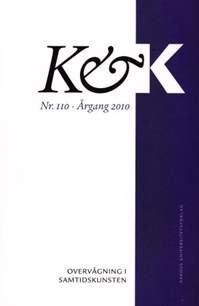RESISTANCE IS FERTILE – OM OVERVÅGNINGENS OLIGOPTISKE BLIK
DOI:
https://doi.org/10.7146/kok.v38i110.15771Keywords:
overvågning, Latour, oligoptikonAbstract
RESISTANCE IS FERTILE – ON THE OLIGOPTIC GAZE OF SURVEILLANCE
This article sets media artist Jill Magid’s performative artefact “Surveillance Shoe | Legoland” (2000‑7) in dialogue with Bruno Latour’s notion of oligopticon. Both address and discuss the possibility of conceptualizing surveillance as an always specific, multiple, and situated phenomenon, and thus question dominant metaphors in surveillance discourse, e.g. panopticon and Big Brother.
The surveillance of Danish citizens commences at their first breath, as they are assigned a personal identification number immediately after being born. This enables inspections and interventions in many diverse ways by the state and other actors during the citizen’s life. Being merely one example of how surveillance seems to penetrate every aspect of everyday life, it seems fair to suggest that surveillance is, indeed, a ubiquitous phenomenon of modern society. On first glance, Jill Magid’s artefact exemplifies this ubiquitous surveillance situation. The artefact comprises a stiletto, an IR surveillance camera, a battery pack, and a wireless transmitter. The surveillance camera is pointed up the performer’s leg, thus presenting us with an extreme worm’s eye view of the world, focusing on the performer’s lower leg and often on her thigh and crutch as well.
From one perspective, Jill Magid’s “Surveillance Shoe” addresses how everything is potentially subject to a surveillant gaze — nothing is too intimate. From another perspective, however, the artefact is an example of how contemporary art investigates the limits and detailed aspects of particular surveillance situations, and of how surveillance technologies co-produce exactly those versions of the reality they gaze upon. In accordance with Bruno Latour’s concept ‘oligopticon’, the artefact points out that the surveillor holds a very precise — yet limited and fragile — view whose only way of seing anything meaningful is by being aggregated to a larger composition.
The concept of the oligopticon questions generalized notions of surveillance such as ‘Big Brother’ and the panopticon, and the dystopian angst and utopian thrills, that such notions often evoke. Directly as well as indirectly, those models of surveillance are widely referred to in both surveillance studies and in public discussions of surveillance and as such they have become ‘ideal models’, against which surveillance situations are often compared. In contrast, this paper argues with Latour and Magid that such models are unable to help us grasp the ‘core’ of surveillance precisely because they claim that there is such a core, wheras all there is in fact are particular compositions of surveillance with each their specific effects. The concept of oligopticon offers, on the other hand, a sensitivity towards the possibility of resisting preconceived notions of what surveillance is supposedly about. And even though it can by no means be understood as an alternate general model of surveillance, the concept makes it possible to conduct a richer enquiry into the particular composition of surveillance phenomena.
Downloads
Published
How to Cite
Issue
Section
License
Tidsskriftet følger dansk ophavsret.





